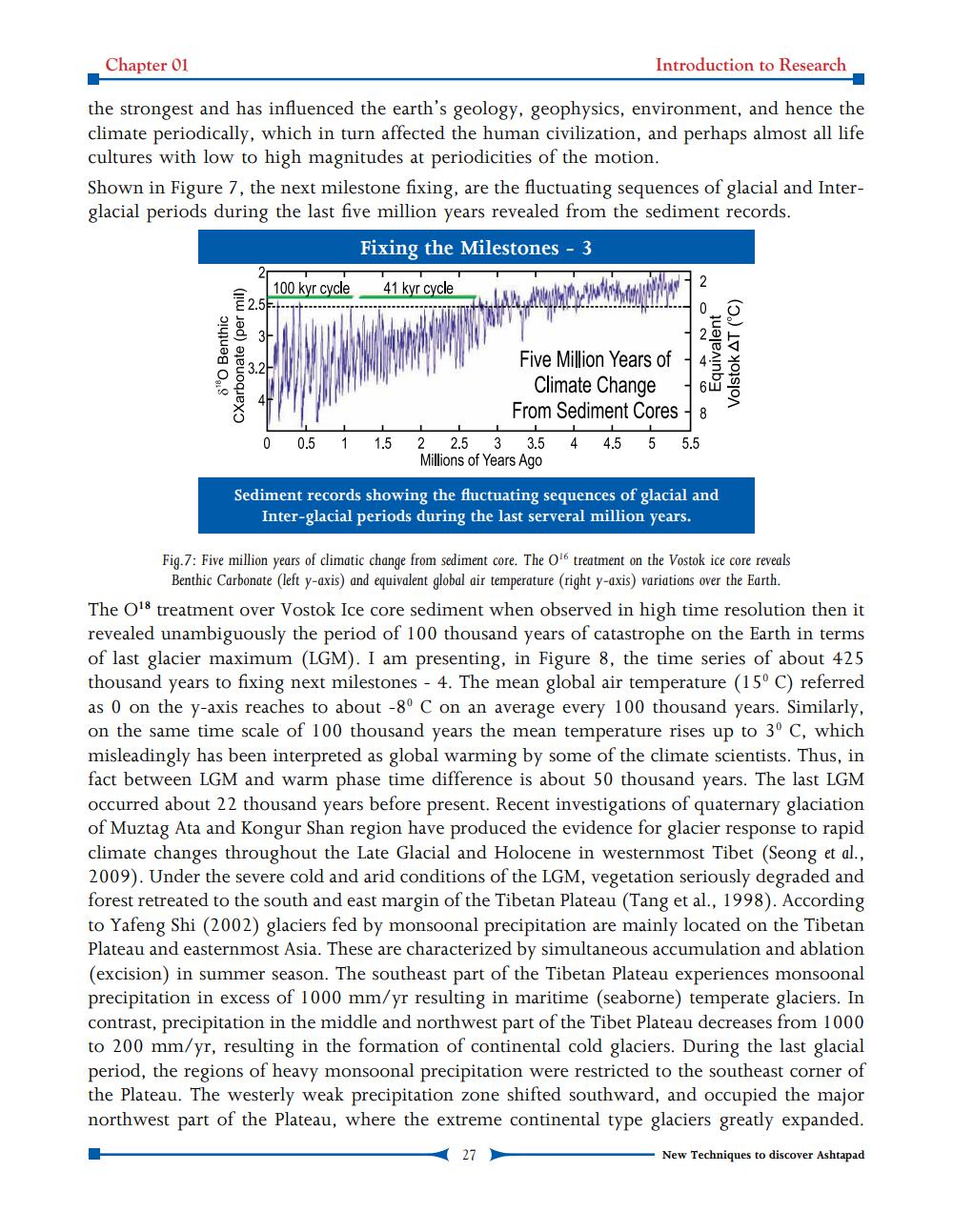________________
Chapter 01
Introduction to Research
the strongest and has influenced the earth's geology, geophysics, environment, and hence the climate periodically, which in turn affected the human civilization, and perhaps almost all life cultures with low to high magnitudes at periodicities of the motion. Shown in Figure 7, the next milestone fixing, are the fluctuating sequences of glacial and Interglacial periods during the last five million years revealed from the sediment records.
Fixing the Milestones - 3
00 kyr cycle
41 kyr cycle
dheit
2.5F
Tron
8o Benthic CXarbonate (per mil)
Equivalent Volstok AT (C)
Five Million Years of
Climate Change
From Sediment Cores 2 2.5 3 3.5 4 4.5 5 5.5 Millions of Years Ago
0
0.5
1
1.5
Sediment records showing the fluctuating sequences of glacial and
Inter-glacial periods during the last serveral million years.
Fig.7: Five million years of climatic change from sediment core. The treatment on the Vostok ice core reveals
Benthic Carbonate (left y-axis) and equivalent global air temperature (right y-axis) variations over the Earth. The (18 treatment over Vostok Ice core sediment when observed in high time resolution then it revealed unambiguously the period of 100 thousand years of catastrophe on the Earth in terms of last glacier maximum (LGM). I am presenting, in Figure 8, the time series of about 425 thousand years to fixing next milestones - 4. The mean global air temperature (15° C) referred as 0 on the y-axis reaches to about -8° C on an average every 100 thousand years. Similarly, on the same time scale of 100 thousand years the mean temperature rises up to 3° C, which misleadingly has been interpreted as global warming by some of the climate scientists. Thus, in fact between LGM and warm phase time difference is about 50 thousand years. The last LGM occurred about 22 thousand years before present. Recent investigations of quaternary glaciation of Muztag Ata and Kongur Shan region have produced the evidence for glacier response to rapid climate changes throughout the Late Glacial and Holocene in westernmost Tibet (Seong et al., 2009). Under the severe cold and arid conditions of the LGM, vegetation seriously degraded and forest retreated to the south and east margin of the Tibetan Plateau (Tang et al., 1998). According to Yafeng Shi (2002) glaciers fed by monsoonal precipitation are mainly located on the Tibetan Plateau and easternmost Asia. These are characterized by simultaneous accumulation and ablation (excision) in summer season. The southeast part of the Tibetan Plateau experiences monsoonal precipitation in excess of 1000 mm/yr resulting in maritime (seaborne) temperate glaciers. In contrast, precipitation in the middle and northwest part of the Tibet Plateau decreases from 1000 to 200 mm/yr, resulting in the formation of continental cold glaciers. During the last glacial period, the regions of heavy monsoonal precipitation were restricted to the southeast corner of the Plateau. The westerly weak precipitation zone shifted southward, and occupied the major northwest part of the Plateau, where the extreme continental type glaciers greatly expanded.
27
New Techniques to discover Ashtapad




